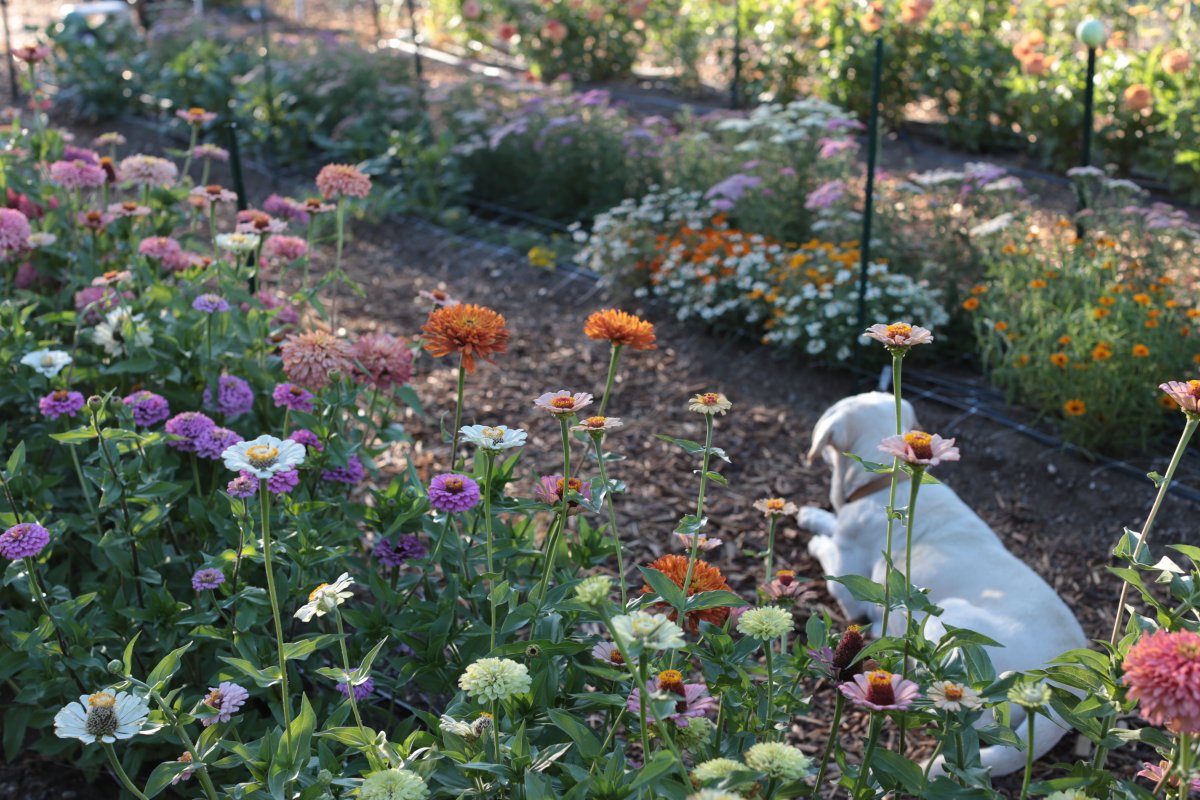
OUR STORY
We are a family run zinnia breeding farm, Tiffany and Mike Jones. I am the designer, artist, and farmer. Mike is the engineering brain, heavy lifter, and head supporter.
I (Tiffany) grew up in Orange County in an area surrounded by farms and fields of tomatoes, corn, strawberries, and flowers. With the support of my dad, who loved gardening, I got to grow my own flowers as a little girl - my favorite was a particularly beautiful peachy-colored gladiolus. Mike grew up with a flower-loving mother, understanding the value of growing plants and now helps develop medical devices.
Flowers have always been my first love. A floral designer at 19, I went on to study Ornamental Horticulture and to get a degree in Landscape Architecture, giving me a more comprehensive understanding of flowers and plants. Eventually I focused on growing cut flowers in San Clemente, California for local wholesale markets. During my first year I noticed that some zinnias I had grown in soft shades of blush and peach would sell out at the wholesaler I worked with, before I had finished unloading my cart. A spark was ignited and, in order to stand out in my crowded market, I began my zinnia breeding journey.
As part of my flower farming adventure, I planted all kinds of perennials and annuals, including ‘Giant Cactus’ zinnias. While I’d grown zinnias before, the ‘Giant Cactus’ variety was so dynamic with its twisted, twirling, tubular petals, and massive flower heads. It was unlike any flower I’d ever seen. I brought them faithfully to market each week and watched as the champagne, blush and peach-colored ones were snatched up before I could even finish unloading the rest of my flowers. Tucked in designers’ arms where no one else could claim them, the designers looked like they’d just scored the best deal and hoped no one else noticed until the bunches were paid for, irrevocably their own. This happened every week and there simply weren’t enough of those colors in my mix to satisfy the demand. With only mixes of multiple colors available commercially, I decided to save the last of my favorites at the end of the season for the bees to pollinate thinking I would grow the seed and have just the colors I wanted.
Silly me. Simply saving my favorites was no guarantee I’d get more of the same. In fact, among my new seedlings, there were far more of every color I didn’t want! In spite of studying Ornamental Horticulture and Landscape Architecture in college I was never exposed to the specifics of zinnia breeding. I knew the general rules and process but had no idea how to actually pollinate a zinnia. In fact, couldn’t even identify the necessary parts. Undaunted, the compulsion to learn more drove me to search online for more information.
I didn't really understand what was involved and began investigating and researching everything I could find about breeding zinnias. Once I had cataloged and organized the information so I could use it as a reference guide, my family encouraged me to make that information available to everyone with an interest in breeding zinnias. Sharing the information in short videos and brief posts was how I started. The response of people wanting to know more was unexpected and overwhelming.
Fast forward several years of investigating and writing and I've complied The Zinnia Breeder's Handbook: A Comprehensive Guide for Flower Farmers, Gardeners and Enthusiasts sharing everything I've learned and been taught all about zinnia breeding for anyone to try. All the while, I continued developing my seed lines and pursued developing new varieties.
After growing in San Clemente for several years, we moved to Gardnerville, Nevada. The farm is much larger, and our dry, hot summer are perfect for growing and developing new varieties. Our focus is breeding beautiful, elevated, unique cut flower zinnias with the goal of bringing these new forms and previously unavailable colors to growers at every level.
Cheers!
Tiffany
